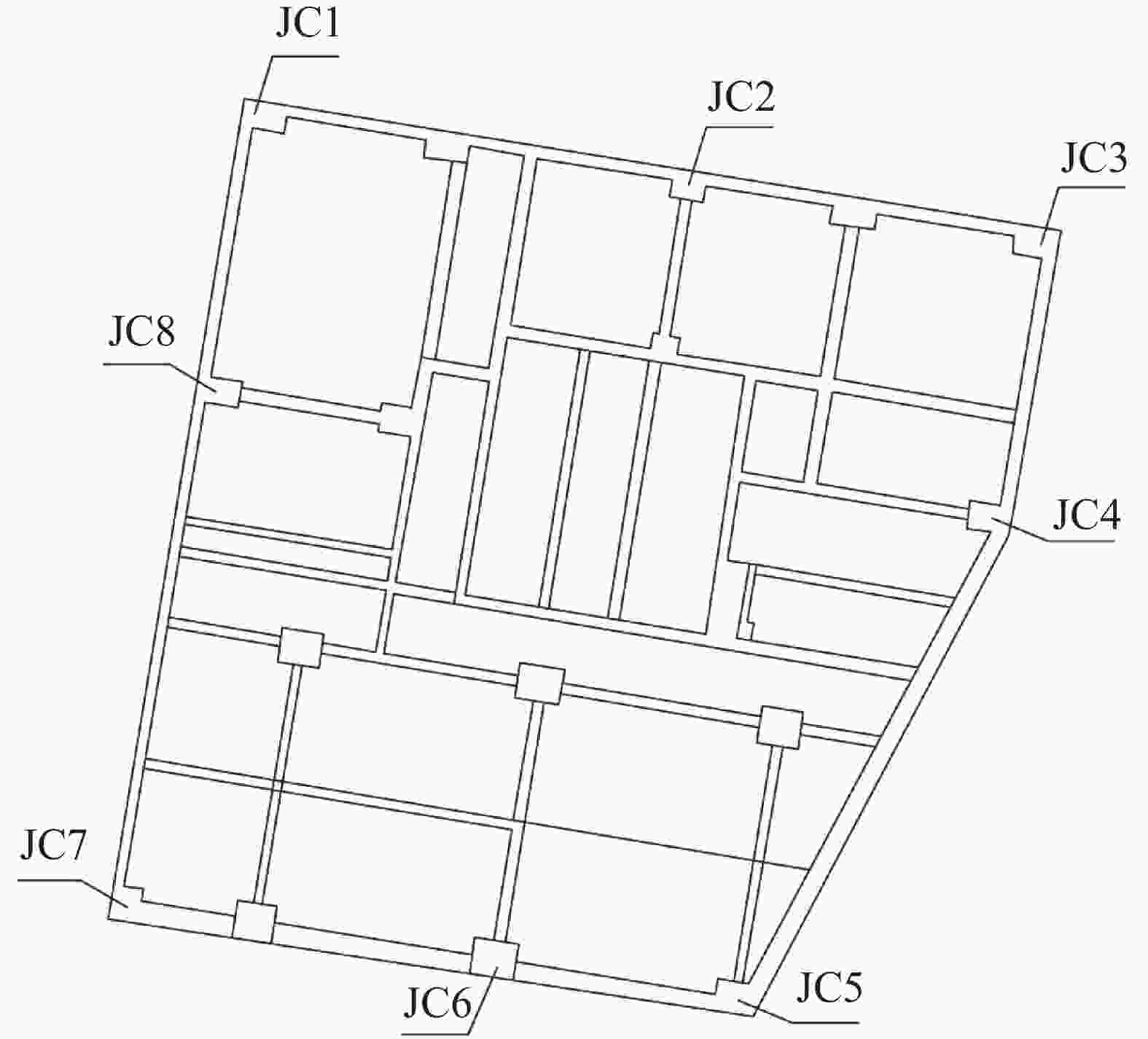Early warning of settlement and deformation of high-rise buildings on soft foundations in karst areas
-
摘要: 为合理保证岩溶区软基高层建筑的运营安全,文章以建筑沉降变形监测成果为实例基础,在建筑变形特征及成因分析基础上,通过稳定性、极限变形及变形速率3类判据综合实现其预警研究。结果表明:岩溶区软基高层建筑具有特殊的沉降特征,地基土和地下水变化是其出现沉降或差异沉降的主要影响因素;同时,不同判据的预警结果存在一定差异,按照不利原则,综合确定3个监测点的预警等级为Ⅲ级,该建筑沉降危害程度一般,但不仅需加强监测频率,观测其后续变化趋势,还应采取加固措施。Abstract:
The background of this article pertains to a high-rise building project, which encompasses a building land area of about 4,630 m2 and features a roughly square shape in its plane. The safety classification of the building structure is designated as Level 2, while the foundation design is categorized as Level A. The foundation form is raft foundation. This building project is of high engineering importance. According to the survey results, underlying strata of the building foundation are mainly composed of clay and limestone layers, each possessing distinct engineering properties that are generally unfavorable. In addition, the average annual rainfall in the project area is 1,107.27 mm, and the dissolution effect of the bedrock will continue. Even worse, the building has already undergone unfavorable deformation. Therefore, to ensure the safe operation of the building, it is necessary to conduct research on early warning of its settlement and deformation. In this study, a total of three types of warning criteria were constructed, namely, stability criterion, ultimate deformation criterion, and deformation rate criterion. Among them, the implementation of stability criterion involves sharp point mutation analysis. This technique derived mutation characteristic values from sharp point mutation analysis of building settlement data and used these values to assess the stable state of building settlement. The ultimate deformation criterion was calculated with the use of the ultimate displacement formula to obtain the ultimate deformation value. This value was then combined with existing monitoring data to construct corresponding criterion indicators. The implementation of the deformation rate criterion was conducted with the rescaled range method, which calculated the Hurst index through rescaled range analysis of building settlement data. This analysis evaluated the development trend of building settlement and deformation. Giving the differing emphases of the three criteria, the early warning level of building settlement and deformation, determined based on principle of unfavorable conditions, is deemed reasonable and accurate through comparative analysis. According to the analysis results, there is a significant difference in settlement and deformation among the monitoring points of the building, with a range of 22.76−56.27 mm, indicating notable settlement characteristics. The primary causes of this settlement are the soil and groundwater conditions of foundation. In the process of early warning of building settlement and deformation, the analysis mainly focuses on monitoring points JC3−JC5. The stability criterion shows that the △ values of the three monitoring points are all greater than 0, indicating that they are all in a stable state, and their corresponding early warning levels of settlement and deformation fall into Levels I−III. The range of evaluation indicators for ultimate deformation criterion is from 0.61 to 0.74, corresponding to the early warning Levels II−III of settlement and deformation, that is, the early warning level of JC5 monitoring point falls into Level II, and the other two monitoring points are Level III. The deformation rate criterion shows that the Hurst index values of the three monitoring points are all less than 0.5, indicating a decreasing trend in the rate of building settlement and deformation. The trend level of JC3 monitoring point is Level 2, while that of the other two monitoring points is Level 1. By comparison, based on the principle of unfavorable conditions, the early warning level of the three monitoring points is determined to be Level III. Therefore, the degree of settlement hazard for this building is moderate. It is necessary to not only increase the monitoring frequency to observe subsequent changes but also to take reinforcement measures. Through this study, a novel approach has been developed for the early warning of building settlement and deformation. This method offers a theoretical basis for ensuring the safe operation of buildings in later stages and holds significant practical implications. -
表 1 趋势等级划分标准
Table 1. Grading standard of trend
趋势等级 1级 2级 3级 c值范围 c<0.15 0.15≤c<0.35 c≥0.35 表 2 高层建筑沉降变形预警等级划分标准
Table 2. Classification standard for early warning of settlement and deformation of high-rise buildings
预警分级 Ⅰ级—绿色 Ⅱ级—黄色 Ⅲ级—橙色 Ⅳ级—红色 稳定性判据 稳定状态 稳定状态 稳定状态 不稳定状态 极限变形判据 Fs≤0.50 0.50<Fs≤0.65 0.65<Fs≤0.80 Fs>0.80 变形速率判据 下降趋势 上升趋势,且趋势
等级为1级上升趋势,且趋势
等级为2级上升趋势,且趋势
等级为3级建议措施 建筑沉降危害程度轻微,其现有稳定性较好,无需采取任何措施 建筑沉降危害程度较小,需加强监测频率,观测其后续变化趋势 建筑沉降危害程度一般,不仅需加强监测频率,观测其后续变化趋势;还应采取加固措施 建筑沉降危害程度较高,不仅需加强监测频率,观测其后续变化趋势;还应立即撤出建筑内人员,并采取加固措施 注:以3类预警判据中的最不利分级为最终预警等级。
Note: The most unfavorable classification among the three types of early-warning criteria is determined as the final early-warning grade.表 3 地层物理力学参数
Table 3. Physical and mechanical parameters of the strata
地层岩性 重度/kN·m−3 弹性模量/MPa 泊松比 黏聚力/kPa 内摩擦角/° 填土 19.0 10 0.20 7.62 8.89 黏土 20.0 10 0.44 5.85 5.13 溶蚀灰岩 22.1 9300 0.70 21000 26.79 灰岩 24.8 10300 0.29 23000 33.11 表 4 稳定性判据的结果
Table 4. Results obtained by stability criterion
监测点编号 拟合结果 突变特征参数 稳定性评价 拟合方程 拟合度 q值 p值 Δ值 状态类型 稳定程度排序 JC3监测点 y=t4−289t2+ 12 258 t0.957 −289 12258 3.864×109 稳定 2 JC4监测点 y=t4−314t2+ 12 794 t0.965 −314 12794 4.172×109 稳定 1 JC5监测点 y=t4−319t2+ 12 312 t0.961 −319 12312 3.833×109 稳定 3 表 5 极限变形判据的结果
Table 5. Results obtained by ultimate deformation criterion
监测点编号 拟合方程 拟合度 极限累计值/mm 现有累计值/mm 分级指标Fs 预警等级 排序 JC3监测点 y=t/( 0.0515 +0.0154 t)0.921 64.80 47.95 0.74 Ⅲ级 1 JC4监测点 y=t/( 0.0507 +0.0123 t)0.948 81.55 56.27 0.69 Ⅲ级 2 JC5监测点 y=t/( 0.0488 +0.0133 t)0.937 75.20 45.87 0.61 Ⅱ级 3 表 6 变形速率判据的结果
Table 6. Results obtained by deformation rate criterion
评价指标 JC3监测点 JC4监测点 JC5监测点 Hurst指数 0.424 0.486 0.453 置信区间 [0.386,0.451] [0.449,0.518] [0.415,0.486] 拟合度 0.954 0.936 0.942 表 7 建筑沉降变形的综合预警结果
Table 7. Comprehensive results of the early warning of building settlement and deformation
监测点编号 JC3监测点 JC4监测点 JC5监测点 稳定性判据 Ⅰ–Ⅲ级 Ⅰ–Ⅲ级 Ⅰ–Ⅲ级 极限变形判据 Ⅲ级 Ⅲ级 Ⅱ级 变形速率判据 Ⅰ级 Ⅰ级 Ⅰ级 综合等级 Ⅲ级 Ⅲ级 Ⅲ级 -
[1] 石晟, 杜东升, 徐敬海, 王曙光. 基础隔震结构基于实时监测数据的多级预警及其在南京博物院老大殿中的应用[J]. 建筑结构学报, 2022, 43(4):47-57.SHI Sheng, DU Dongsheng, XU Jinghai, WANG Shuguang. Multi-level early-warning system for base-isolated structures based on real-time monitoring data and its application on the Old Hall of Nanjing Museum[J]. Journal of Building Structures, 2022, 43(4): 47-57. [2] 沈阳, 徐磊, 郑冠雨, 章超, 匡志平. 考虑风险因素耦合的超高层施工预警方法研究[J]. 郑州大学学报(工学版), 2021, 42(4):98-104, 110.SHEN Yang, XU Lei, ZHENG Guanyu, ZHANG Chao, KUANG Zhiping. Research on early-warning method for super high-rise building construction considering coupling effect of risk factors[J]. Journal of Zhengzhou University (Engineering Science), 2021, 42(4): 98-104, 110. [3] 沈阳, 徐磊, 王少纯. 基于风险管理的整体钢平台变形预警指标研究[J]. 中国安全科学学报, 2021, 31(6):56-63.SHEN Yang, XU Lei, WANG Shaochun. Research on early-warning index for deformation of integrated scaffolding and formwork with steel platform based on risk management[J]. China Safety Science Journal, 2021, 31(6): 56-63. [4] 左自波, 潘曦, 黄玉林, 汪小林, 张龙龙. 超高层ICCP安全监测与控制的预警指标研究[J]. 中国安全科学学报, 2020, 30(1):53-60.ZUO Zibo, PAN Xi, HUANG Yulin, WANG Xiaolin, ZHANG Longlong. Early warning indicators for safety monitoring and control of super high-rise ICCP[J]. China Safety Science Journal, 2020, 30(1): 53-60. [5] 肖鸿斌, 金耀岷. 深埋串珠状溶洞的超高层基础设计案例分析[J]. 中国岩溶, 2023, 42(2):382-390. doi: 10.11932/karst20230209XIAO Hongbin, JIN Yaomin. Case study on super high-rise foundation design of the deep-buried beaded karst cave[J]. Carsologica Sinica, 2023, 42(2): 382-390. doi: 10.11932/karst20230209 [6] 曹贤发, 刘玉康, 刘之葵, 张炳辉. 基于强溶蚀带特征的地基岩溶发育程度评价方法[J]. 中国岩溶, 2020, 39(4):577-583.CAO Xianfa, LIU Yukang, LIU Zhikui, ZHANG Binghui. Evaluation method of development degree based on features of intense dissolution layer[J]. Carsologica Sinica, 2020, 39(4): 577-583. [7] 李想, 尹骥, 卫佳琦, 韦马季. 深覆盖岩溶地区高层建筑桩基优化实践[J]. 中国岩溶, 2019, 38(4):591-599.LI Xiang, YIN Ji, WEI Jiaqi, WEI Maji. Optimization of pile foundation for high - rise buildings in deep - covered karst areas[J]. Carsologica Sinica, 2019, 38(4): 591-599. [8] 代长生. 基于变形数据分解处理的基坑危险性潜势分级研究[J]. 地质与勘探, 2022, 58(6):1271-1280. doi: 10.12134/j.dzykt.2022.06.011DAI Changsheng. Hazard potential classification of foundation pit based on deformation data decomposition[J]. Geology and Exploration, 2022, 58(6): 1271-1280. doi: 10.12134/j.dzykt.2022.06.011 [9] 耿海深, 吕文斌, 栗燊, 蒋国良. 滑坡失稳机理分析及预警预测研究[J]. 西北师范大学学报(自然科学版), 2021, 57(6):103-109.GENG Haishen, LYU Wenbin, LI Shen, JIANG Guoliang. Mechanism analysis and early warning prediction of landslide instability[J]. Journal of Northwest Normal University (Natural Science), 2021, 57(6): 103-109. [10] 李晓斌. 软岩隧道大变形预警分级研究及发展趋势[J]. 地质与勘探, 2021, 57(5):1149-1157. doi: 10.12134/j.dzykt.2021.05.019LI Xiaobin. Early warning classification of large deformation in soft rock tunnels and its development trend[J]. Geology and Exploration, 2021, 57(5): 1149-1157. doi: 10.12134/j.dzykt.2021.05.019 [11] 宁波, 刘玉健, 王安东. 巨型古滑坡的稳定性评价及发展趋势分析[J]. 大地测量与地球动力学, 2022, 42(5):515-519.NING Bo, LIU Yujian, WANG Andong. Stability evaluation and development trend analysis of giant ancient landslide[J]. Journal of Geodesy and Geodynamics, 2022, 42(5): 515-519. [12] 薛晓辉, 周玲, 秦爱红. 库岸涉水滑坡危险性现状分析与预测评价[J]. 中国安全生产科学技术, 2021, 17(5):169-175. doi: 10.11731/j.issn.1673-193x.2021.05.026XUE Xiaohui, ZHOU Ling, QIN Aihong. Status analysis and prediction assessment on risk of wading landslide on reservoir bank[J]. Journal of Safety Science and Technology, 2021, 17(5): 169-175. doi: 10.11731/j.issn.1673-193x.2021.05.026 [13] 邓小鹏. 基于信息分解的滑坡变形稳定性评价及预警分析[J]. 人民长江, 2021, 52(5):101-107.DENG Xiaopeng. Landslide deformation stability evaluation and early warning analysis based on information decomposition[J]. Yangtze River, 2021, 52(5): 101-107. -





 下载:
下载:





